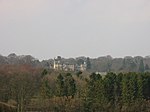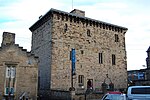Anick
Former civil parishes in NorthumberlandNorthumberland geography stubsPages including recorded pronunciationsUse British English from August 2019Villages in Northumberland

Anick ( AY-nik) is a village and former civil parish, now in the parish of Sandhoe, in Northumberland, England, situated to the north of Hexham. In 1881 the parish had a population of 153. Anick should not be confused with Alnwick, pronounced ; a much larger town also in Northumberland, but some 35 miles (56 km) further north.
Excerpt from the Wikipedia article Anick (License: CC BY-SA 3.0, Authors, Images).Anick
A69,
Geographical coordinates (GPS) Address Nearby Places Show on map
Geographical coordinates (GPS)
| Latitude | Longitude |
|---|---|
| N 54.98 ° | E -2.07 ° |
Address
A69
NE46 4JT
England, United Kingdom
Open on Google Maps









